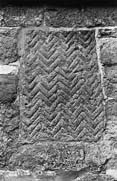Select a site alphabetically from the choices shown in the box below. Alternatively, browse sculptural examples using the Forward/Back buttons.
Chapters for this volume, along with copies of original in-text images, are available here.
Object type: Grave-cover
Measurements: L. 76 cm (30 in); W. 58 > 51 cm (23 > 20 in); D. Built in
Stone type: Orange-brown, ferruginous limestone. Tealby Limestone, Lower Cretaceous of Lincolnshire
Plate numbers in printed volume: Ill. 419
Corpus volume reference: Vol 5 p. 287-288
(There may be more views or larger images available for this item. Click on the thumbnail image to view.)
Part of a flat tapered grave-cover, probably the head end, with incised decoration on its upper surface. No other faces are visible. .
A (top): Completely covered with close-spaced running chevrons. Their cutting is quite accurate since the chevrons decrease in size to take account of the taper. Their consistent termination on the visible edges of the stone suggests that these are the original edges of the cover.
Appendix A item (stones dating from Saxo-Norman overlap period or of uncertain date).
As Pevsner noted (Pevsner and Harris 1964, 326), a stone with this sort of massed chevron decoration is most readily paralleled in Romanesque wall decoration or tympana. Examples of the latter are found at Great Canfield, Essex; Linley, Shropshire; Redmarshall, co. Durham; or in a panel within a tympanum at Willersley, Herefordshire (Keyser 1927, figs. 2, 27B). Similar decoration is nevertheless also found on shafts, as on three faces of Burton in Kendal 3, Westmorland (Bailey and Cramp 1988, 83, ills. 190–2) or on a recently discovered grave-marker from Coppergate in York (Hall 1980, 30, ill. 33; Lang 1991, 103, ills. 333–6). The coherence of the form and decoration of this piece, however, plus its size, confirm that it is a grave-cover as Butler (1963–4, 106; 1964, 117) asserts. Among covers its analogies are generally with those exhibiting incised geometrical patterning as their sole or principal decoration, such as those at Birstall, Yorkshire WR (Collingwood 1915, 145) or Bolam 2, Northumberland (Cramp 1984, 238, pl. 235, 1333–4). Like them it probably dates from the early post-Conquest period.



